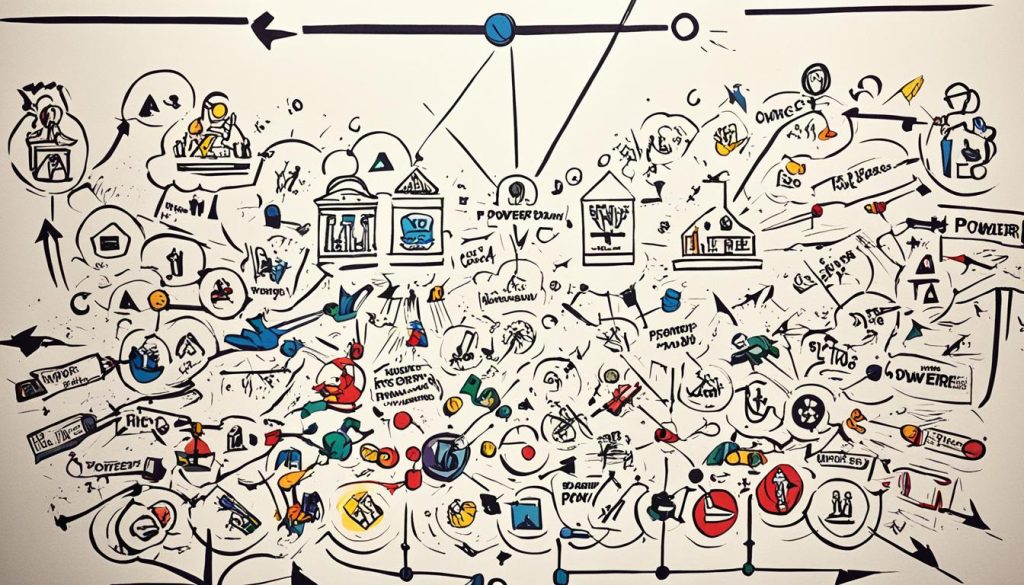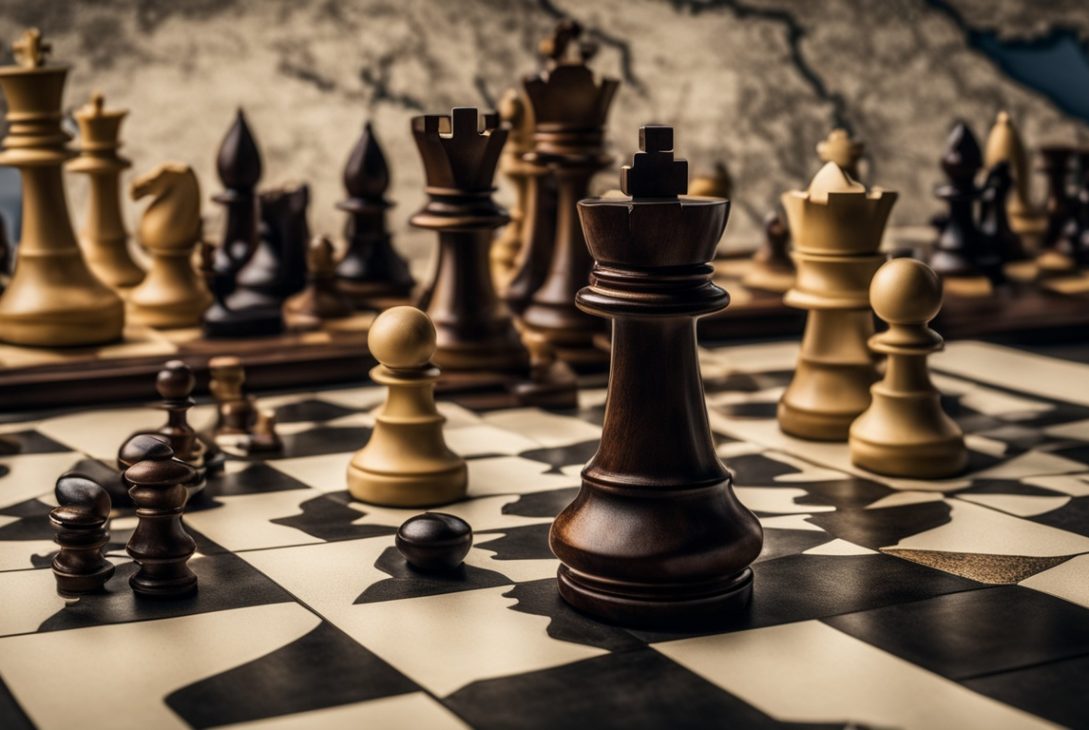In the realm of political analysis, Mark J. Kaswan’s work stands out. His book “Politics as the Dynamics of Power” dives deep into how power works. It looks at how power plays out in decisions, especially when there’s inequality.His insights show that power is all about the connections between people, groups, and society. This view affects many areas, like election analysis and policy evaluation.
Key Takeaways
- Kaswan defines politics as the process of decision-making and its effects, involving the dynamics of power.
- Power exists in relationships between individuals, institutions, and individuals and institutions, emphasizing its relational nature.
- Power dynamics operate under conditions of inequality, shaping decision-making processes and outcomes.
- Understanding power relations is crucial for political analysis, policy evaluation, and political forecasting.
- Kaswan’s work offers insights into navigating power structures and promoting equity and inclusion.
Kaswan’s look into power and politics focuses on how decisions are made. It looks at the influence of power and how this changes with inequality. Many studies on health policies show this model is key. It’s important for political analysis to find ways to stop marginalization. This work helps create fair and inclusive communities1.
Understanding the Concept of Politics
Political analysis explores how power influences social relations and decisions. Mark J. Kaswan looks at politics as the power balances in relationships, especially when there’s inequality.
Politics as the Dynamics of Power
Kaswan explains politics as the power plays between people. It’s not just about making choices. It’s also about how those choices impact everyone involved.2 Power isn’t fixed. It changes in our interactions with others and organizations.
The Relational Nature of Power
In relationships, power shows up in different ways. It might be formal, like when someone has authority, or more informal, like someone’s strong influence.2 Power isn’t all in one place. Instead, it’s spread out. It’s about how we can change situations and influence others. Kaswan stresses that power’s about how we interact and deal with differences.
Power is not a possession but a relationship. It is not a thing but a process. It is not static but dynamic, ever-changing, ever-shifting in its locus and forms.
The core of Kaswan’s view on politics is about the power behind making decisions. It’s how power shapes what decisions are made and who they affect.2 He shows us how understanding power’s role helps us see how political situations happen and their outcomes, especially when there’s unfairness.
The Process of Decision-Making
The decision-making process is key in politics, says Mark J. Kaswan. Power plays a big role by defining decisions and influencing people to make certain choices.
Explicit and Implicit Decision-Making Processes
Some decisions are clear and open, while others are hidden. Political analysis shows that both types involve power. This power guides actions and choices, even when we’re not aware of it.
Power’s Influence on Decision-Making
Power influence greatly affects who gets heard, what issues matter most, and which choices are on the table. In explicit decisions, like official policy changes, power structures have their say. However, implicit decisions can also be influenced by unseen powers under the surface.
Decision analysis has been around for over 50 years, helping us understand the role of power in choices.3 The Bayesian model, separating beliefs from preferences, is now a practical tool for various groups.3
| Decision Analysis Approach | Key Characteristics |
|---|---|
| Bayesian Paradigm |
|
| General Approach |
|
Understanding power’s role in decision-making, explicit and implicit, leads to insights. These insights help in understanding political dynamics and the influence of power on key decisions.
Conditions of Inequality
Kaswan defines politics by looking at the conditions of inequality. This is key to understanding power. Over the last few decades, Income inequality and political polarization have risen worldwide. This has led to the continuation of social inequalities.4
Power Dynamics and Social Inequalities
In worlds of inequality, some have more power and privilege than others. A study using World Values Survey data from 1990 to 2020 shows a strong link. It found that as income inequality grows, so does political polarization.4
The United Nations’ Sustainable Development Goals strive to “reduce income inequalities”. Yet, since the 2000s, income inequality has been on the rise globally. It has led to more crime, limited education access, health problems, social discrimination, and discontent.4
It’s associated with less happiness among the working class and a rise in anti-globalization feelings.4
Income inequality is bad for politics, causing issues like low social mobility, conflicts, and political tensions. It might even lead to more political polarization. Research in the U.S. backs this up. It shows that income inequality significantly affects political polarization and changes in party politics.4
Studies in the U.S. and Europe have looked into the link between income inequality and political polarization. They suggest a strong connection. Knowing these power dynamics is crucial. It can help us fight against oppressive structures. It’s a step towards more equity and inclusion.
Forms and Sources of Power
In political analysis, knowing about different power forms is key. It helps us see how power structures affect our societies and groups. Power takes on many forms. It goes from formal authority, which follows rules, to informal domination, which uses social expectations and relationships.
Authority and Domination
Authority means using power within official rules and laws. It lets certain people or groups make choices, give orders, and expect others to follow. On the flip side, domination is using power unofficially, through social culture and not by direct rules.
Formal and Informal Power Structures
Formal power structures get their power from laws, policies, and institutions like governments. They follow clear rules and procedures when using their power. However, informal power structures work through social relations and cultural traditions. They don’t have official rules but still affect how power is used, often subtly.
Both formal and informal power structures greatly affect our societies and groups. While formal ones guide the proper use of authority, informal ones can support or question the official ways, leading to complex power dynamics. Understanding these dynamics is crucial for anyone looking at political analysis.
By looking at how authority and domination work, alongside formal and informal power structures, researchers and experts learn a lot. They see how relationships, norms, and mechanisms control power in different social and political settings.
Levels and Spaces of Power
Power is at play from individual to institutional and societal levels. We use The powercube framework to explore these different powers. It helps us see how they all connect.5
Individual, Institutional, and Societal Power Dynamics
Power is felt personally in individual relationships and affects our choices and those around us.5 At the institutional level, rules and practices guide how power works. This often keeps some people down.5 Societal power reflects our cultural values and can lead to influencing groups differently.5
Visible and Invisible Power Spaces
Both seeing visible and hidden invisible power is crucial, as Kaswan points out.5 Visible power is clear in decision-making places.5 Invisible power, however, works behind the scenes, shaping how we think and behave.5
Power spaces can either be open, exclusive, or subtly influenced.5 Knowing both seen and invisible power is key for political understanding. It helps fight against injustice.5
| Level of Power | Visible Power Spaces | Invisible Power Spaces |
|---|---|---|
| Individual | Personal relationships, family dynamics | Internalized beliefs, self-perceptions |
| Institutional | Policy-making forums, organizational decision processes | Implicit biases, organizational culture |
| Societal | Public debates, political arenas | Cultural norms, social hierarchies |
The powercube method shows we should look at each aspect on its own first. Then we can see how they interact.5 It gives us the freedom to start our analysis from any of the power aspects. This depends on the situation and what we hope to achieve.5
Political Analysis
In the world of political analysis, the Swedish International Development Cooperation Agency (Sida) is a pioneer. They use a tool called power analysis. This helps show how power can keep people poor or marginalized. It’s very helpful for Swedish development cooperation works.
Sida’s Approach to Power Analysis
Sida’s method looks at creating new kinds of power to fight against the usual power structures. They work on policy evaluations and political risk assessments. Their goal is to make strategies that support democratic development and help people who are often left out.
Power analysis is a key part of understanding poverty better in development work. This is what the Swedish government suggests.
Power Analysis and Swedish Development Cooperation
Sida has a lot of know-how in power analysis. This has helped shape how Sweden does international development work. By addressing power gaps, Sida works to make development more fair and lasting.6
The journal “Political Analysis” is a leader in political science, with high Impact Factor numbers. For example, in 2022, it was ranked 8 out of 187. And in 2020, it was ranked 1 out of 182. These scores show the journal’s strong influence.6
| Year | Impact Factor Ranking |
|---|---|
| 2022 | 8 out of 187 (SSCI) |
| 2020 | 1 out of 182 |
| 2018 | 33 out of 176 |
| 2016 | 5 out of 165 |
| 2014 | 1 out of 161 |
| 2009 | 1 out of 112 |
| 2008 | 1 out of 99 |
| 2007 | 1 out of 93 |
These rankings show that the journal is very important in political science. It supports Sida’s use of power analysis in making development work better.6
Navigating Power Dynamics
In our world, learning to understand power dynamics is key. It helps us see and fight against systems that cause harm.7 Throughout history, leaders have used different methods to keep control, like changing laws, spreading information, and limiting who can vote.
Recognizing and Challenging Power Structures
Power dynamics can be hidden but they affect us all. They might make some people feel less important while keeping strong groups in power.7 In democratic countries, unfair tricks in elections show us the importance of watching out for how power is used.
Power dynamics often operate invisibly, shaping social norms and behaviors in ways that marginalize certain groups and reinforce existing power structures.
We must question power closely to fight unfair control. This involves looking at power from personal, group, and wide society angles.7 The digital age brings new concerns, like how social media and AI can be used to sway elections unfairly.
Promoting Equity and Inclusion
Understanding power dynamics lets us help bring equity and inclusion to those who need it.7 Today, politics and social problems are often twisted to serve personal goals. This makes us question how our data is used in politics.
- Engage in critical self-reflection to identify and challenge ingrained biases and assumptions.
- Amplify marginalized voices and create spaces for diverse perspectives to be heard and valued.
- Advocate for policies and practices that promote equity and dismantle systemic barriers.
Addressing power imbalances brings us closer to creating fairer and more open societies. This work lifts everyone up together.
Power Analysis in Practice
The power analysis approach helps us understand and address issues of power imbalances in development cooperation projects. It uses case studies to give us practical insights. A guide from Sida is full of resources for adding power analysis to many project stages.
Case Studies and Practical Examples
Studies from different countries show the wide use of power analysis. In Tanzania, a study focused on how policies are set, resource distribution, and the role of social ties in decisions.8
In Ethiopia’s analysis, knowledge played a critical role. This shows why understanding local situations and power structures is key.8

Integrating Power Analysis into Development Cooperation
Sida shows how valuable power analysis is in real-world projects. It helps with policy making by looking at different power systems to battle inequalities.8
Power analysis studies start at the country level and are done by local experts. This ensures a close look at the community’s unique features.8
The study includes reviewing materials, talking to people, and surveys. This all helps paint a clear picture of power dynamics.8
| Aspect | Description |
|---|---|
| Resources | The resources and time needed for power analysis varies. Most costs come from the experts’ time.8 |
| Challenges | Comparison of analysis results can be tough due to how Terms of Reference are understood differently.8 |
| Strengths | Emphasizing country-specific knowledge adds to power analysis’s benefits, even if international comparisons are challenging.8 |
By using power analysis in development projects, groups can better see local power issues. This helps identify important players and create actions to fight marginalization and inequality.
Conclusion
Power analysis is key to understanding complex political, economic, and social interactions. It helps us look at power structures closely. By doing so, we can find out why there is inequality and how to fight it.9
This knowledge is critical for fighting oppression and creating fair societies. It allows us to challenge unfair systems through smart strategies. Thus, we can bring about positive social change.
Understanding power is vital in various areas, including community work and policy review. It shows us both clear and hidden sources of power. This insight helps us make choices that disrupt unequal power and promote fairness.
Additionally, analyzing power is crucial for making political choices. It shows where power operates, guiding us in making fair decisions. In doing so, we strive to better society, where everyone’s voice matters and barriers disappear.
FAQ
What is the definition of politics according to Kaswan?
How does Kaswan view the nature of power?
What is the difference between explicit and implicit decision-making processes?
How does power relate to inequality?
What is the difference between authority and domination?
What are the different levels of power dynamics?
What is Sida’s approach to power analysis?
Why is recognizing and understanding power dynamics important?
How can power analysis be used in practice?
Source Links
- https://www.ncbi.nlm.nih.gov/pmc/articles/PMC8573637/
- https://kups.ku.edu/overview
- https://warwick.ac.uk/fac/sci/statistics/staff/academic-research/french/publications/davspolitics_ver1.pdf
- https://www.ncbi.nlm.nih.gov/pmc/articles/PMC8608558/
- https://www.powercube.net/analyse-power/what-is-the-powercube/
- https://www.cambridge.org/core/journals/political-analysis
- https://medium.com/@rudra.komala/unveiling-the-complexities-of-political-engineering-navigating-power-dynamics-982a11fe4737
- https://usaidlearninglab.org/resources/power-analysis-practical-guide
- https://academic.oup.com/book/5889/chapter/149180743
Government analysis Leadership insights Political science Political theory Power dynamics
Last modified: May 22, 2024






